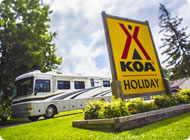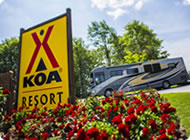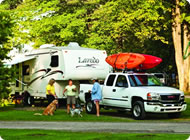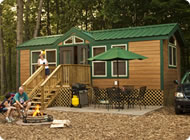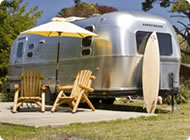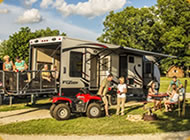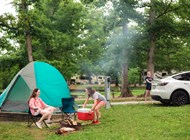Your battery powers every RV adventure, whether you are cruising down the highway or navigating off the beaten path. Understanding the type of battery you have and the factors affecting its health can make a difference in your travel experience.
Learning About RV Batteries
Most RVs have two types of batteries:
- Starting batteries: These batteries provide a quick burst of power with a higher crank amp to start the engine.
- Deep-cycle batteries: Deep-cycle batteries have longer amp hours and offer a consistent power supply to operate your appliances, water pumps and other electrical devices when the RV is not connected to an exterior power source.
There are three main types of deep-cycle RV batteries:
- Flooded lead-acid (FLA): This battery is known for its availability and affordability. It is suitable for those budget-conscious RVers who want to save money. Lead-acid batteries require regular maintenance and have a shorter life span.
- Absorbed glass mat (AGM): This maintenance-free battery is ideal for RV owners who want durability. It is more expensive than FLA batteries, but it handles cold weather better than other battery types. It can still be affected by extreme heat, though. AGM batteries are also spill-proof, making them longer lasting.
- Lithium-ion (LiON): These high-performing batteries are perfect for frequent RVers and off-grid campers. They can be sensitive to extreme temperatures and are more expensive than FLA and AGM batteries. However, lithium-ion batteries are lightweight with a faster recharge time and a longer life span. It is important to note that if the RV did not come with LiON batteries, the charging system is not designed to charge them properly and will shorten their life span.
How Long Do RV or Camper Batteries Last?
The life span of RV batteries varies according to their type and other factors, such as usage patterns, charging techniques, weather, climate, service and cleaning:
- Flooded Lead-Acid: 3 to 4 years or roughly 200 to 500 cycles
- Absorbed Glass Mat: 3 to 7 years or about 500 to 800 cycles
- Lithium-ion: Up to about 12 years or approximately 2,000 to 4,000 cycles

Factors Affecting RV Battery Life
Knowing how long camper batteries last is crucial, and so is understanding the elements affecting their life span.
Usage Patterns
Your usage patterns matter in extending the shelf life of RV batteries. Regular use maintains the battery’s overall health while letting the battery sit for long periods can lead to diminished performance and a shorter life span. For lead-acid batteries, infrequent use results in sulfation, degrading its capacity. Active charging and discharging patterns also activate battery chemistry to promote better performance and longer usage.
Charging Practices
Your charging and discharging habits impact the life span of your RV battery. Leaving the battery connected to the charger can shorten its life span. Overcharging can also result in battery gassing, which poses risks of ignition in closed areas.
You do not need to wait for the battery to fully discharge before charging it. Deep discharging significantly reduces battery health and overall life. When a lead-acid battery is discharged too deeply, it can lead to permanent damage to the battery system. If the water level is too low, the plates inside the battery can get exposed, resulting in sulfation. If the electrolyte levels are also low, it can cause uneven discharging across cells. Both improper practices can lead to shorted RV battery cells, which significantly reduce the battery’s capacity.
Environmental Conditions
Temperature and humidity levels influence the overall life span of your RV battery. Extreme temperatures can impact the battery’s health and shorten its shelf life. Hot temperatures can increase the self-discharge rate, while cold temperatures reduce its capacity. In this sense, a low-charged battery during low temperatures may cause the water to freeze, while well-charged ones in the same condition keep them from freezing.
Signs of a Failing RV Battery
Learn how to identify the signs of when to replace batteries to avoid interruptions while on the road or while enjoying your RV camping. Here are some indicators of a failing RV battery:
- Reduced run time: Battery degradation can lead to lower capacity, which results in recharging repeatedly, even with less usage. Reduced run time means replacement is inevitable.
- Difficulty holding a charge: If you experience difficulty holding the charge, it is an indicator of deteriorating key components. If this problem persists, your battery’s health is affected.
- Low voltage: Modern RVs have alarms when batteries are low. If not, you can use a multimeter to check the voltage. For reference, a working, fully charged 12-volt battery should read between 12.6 and 12.8 volts of direct current (VDC).
- Physical damage: When you see swelling or punctured batteries, you need to replace them. These conditions mean the batteries are more susceptible to leaking and accidents, potentially harming your RV and your family.
- Strange smell from the battery: Inspect the battery immediately if you notice a rotten egg smell. If you see damage to the casing and leaking acid, replace the battery as soon as possible.
- Corroded batteries: Chemical reactions between terminals and cables can cause battery failure. The corroded parts hinder the battery’s charging and discharging capabilities.
- Problem starting the engine: A weak battery or damaged components impact the RV’s operation. If you have been experiencing difficulties starting the engine, check the battery for possible replacement.
- Electrical system issues: Batteries are connected to the working condition of your appliances. Flickering lights or frequent problems when using electronic devices are indicators of battery problems.
- Worn battery: After the general life span of an RV battery, you can expect some issues along the way. Once a battery hits the end of its useful life, it is time for a replacement.
Maintenance Tips for RV Batteries
Maintaining your battery is more than just ensuring it lasts as long as possible. It can also save you money on costly repairs and replacements. Regular inspections and cleaning, servicing, proper charging practices and temperature considerations are key to prolonging RV battery life and enhancing its efficiency.
Regular Inspection
As the component that powers your RV and your adventures, regularly checking the battery maximizes its life span. Make it a habit to check the battery before you hit the road. Look for significant or unusual changes like:
- Cracks or leaks on the surface
- Dirt accumulation between components
- Corrosion on the terminals
- Loose connections
- Cracked or broken wires
Proper Charging Techniques
Proper charging practices maximize the shelf life of your RV battery. With the right charging techniques, you can keep the battery running smoothly and improve its health. Check to verify that your charger works with your battery type and follow these charging practices:
- Use the recommended voltage level for your battery.
- Keep the RV battery discharge shallow by only using 20% to 30% of its capacity.
- Charge the battery as soon as it reaches 50% to prevent premature self-discharging.
- Avoid overcharging the battery and leaving it on the outlet.
- Keep track of the charging state using a quality battery monitor.
Cleaning and Terminals Check
Keeping the batteries clean is necessary for its functionality and efficiency.
- Keep batteries clean and remove any dirt and debris from the surface and components.
- Use a wire brush to clean any powdery deposits between terminals and cable clamps.
- Sprinkle baking soda onto terminals with chemical deposits and brush it gently with water.
- Check for signs of wear or damage on the terminals to prevent serious problems.
Temperature Considerations
Temperature and humidity significantly affect the battery’s working condition and life span. Monitor the temperature and humidity levels to keep your battery in its best condition. RV batteries work optimally from 50°F to 80°F with a humidity of around 30% to 50%. Going beyond the ideal conditions strains the battery, impacting its health and reducing its life span. To help your battery better handle temperature fluctuations, be sure to:
- Inspect water levels regularly for lead-acid batteries.
- Always use distilled water to refill battery fluid.
- Ensure good ventilation within the battery compartment area.
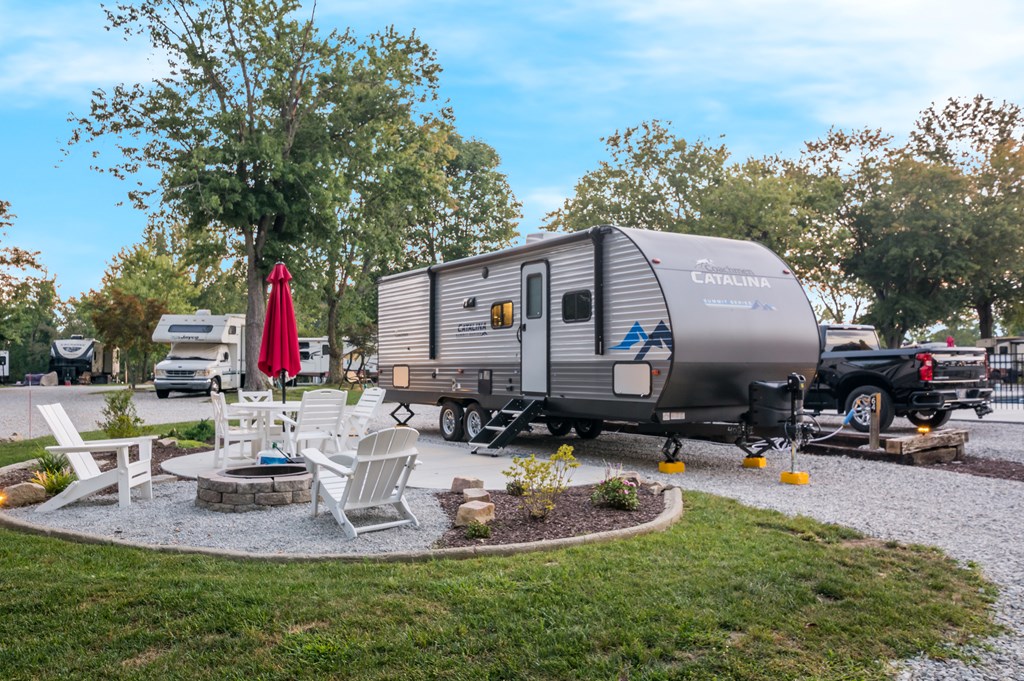
Proper Storage
Here are some storage practices for optimal performance and longevity:
- Keep batteries in a cool, dry location to prevent corrosion that decreases battery health.
- Unhook the battery and remove it from the vehicle if you plan to be off-road for some time.
- Take the battery out in winter because extremely cold weather can kill the active cells.
- Check and recharge the removed battery every couple of months to ensure it does not die.
- Invest in a trickle charger and use it to keep your battery health solid while not being connected to any system.
Optimal Usage Practices
Your battery health also depends on your RV usage. Take care of your battery through the following tips:
- Turning off the lights and other appliances: Make sure to turn off the lights, storage, fans and RV fridge when not in use.
- Try not to use an inverter all the time: Inverters take up too much of your RV battery. It can drain the battery quickly, especially the big ones. Extend battery life by turning it off when not needed or plugging it into the campground hookup so it does not take any juice from the battery.
- Close the RV windows before turning off the engine: Your starting RV battery powers the windows and sunroof. To avoid draining the battery, remember to close them before you turn off the engine.
- Install a battery disconnect switch: Even when electronics are not in use, your RV battery continues to provide power, affecting your battery health. Avoid parasitic draw by using a disconnect switch that turns off the electrical outlets when the RV is not in service.
Choosing the Right Type of Battery
If you want to upgrade the RV battery, consider various factors, including your power needs, cycle life, temperature performance, size and cost. For example, if you want an affordable option, FLA batteries are good, except for their short life span and heavy maintenance. Lithium-ion batteries are more expensive upfront but deliver the best performance with fast recharge time and more cycles.
Why Trust Kampgrounds of America for RV Information?
When it comes to RV guides and tips, you can count on KOA for the latest and relevant information. They are your seasoned source of anything RV-related for every road trip, from maintaining battery systems to choosing the right campsite.
Count on KOA to stay current with industry trends and technological advancements, so you are always getting the most up-to-date details. As your trusted nationwide campground provider for RV users, they take the time to curate insights and tips you need to optimize your RV’s comfort and efficiency.
With more than 500 campgrounds across North America, trust KOA to make every adventure worthwhile. Enhance your travels with knowledge and practical experience for more informed decisions and memorable RV trips.
Learn More About Successful RV Camping With KOA
Dive into our comprehensive RV blogs to maximize your RV camping experience. KOA is dedicated to your RV journey success and offers relevant tips and a variety of campsites to choose from. Travel confidently and enjoyably with KOA.
About the Author: Kampgrounds of America
Kampgrounds of America is the largest system of open-to-the-public campgrounds in the world, with over 500 locations across the United States and Canada. Founded in Billings, MT in 1962, KOA’s family of campground brands – KOA Journey, KOA Holiday and KOA Resort – today serve more than a million camping families each year. KOA is dedicated to “connecting people to the outdoors and each other” by providing people with a variety of camping experiences and the information they need to make the most of their camping trip. Read more of their camping and travel resources by visiting KOA.com/blog.






